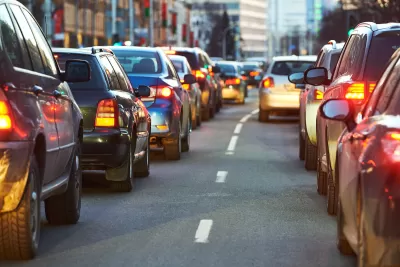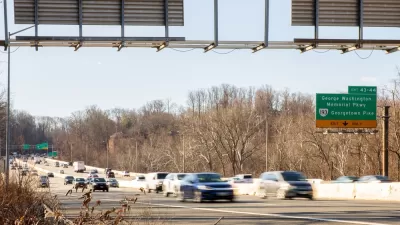Average vehicle miles driven rose in almost every major metropolitan area between 2019 and 2024.

The reduction in driving brought on by the pandemic doesn’t seem to be a lasting effect, writes Linda Poon in Bloomberg CityLab. In fact, between May 2019 and May 2024, total miles traveled (VMT) in the United States grew by 12 percent to the highest level ever recorded, according to a report from StreetLight Data.
The report also suggests that VMT is rising faster now than it was when driving levels first rebounded from the pandemic in 2021 — a worrying trend for advocates working to reform transportation, the largest contributor to US carbon emissions.
VMT grew in almost every U.S. metro area and in most central city neighborhoods, including a 14.7 percent growth in New York City’s core, highlighting the potential benefits of the city’s now-canceled congestion pricing plan.
Across the country, famously car-centric Los Angeles saw a 17 percent decline in average daily VMT. “Other areas among the top five are also in California, including the Oxnard-Thousand Oaks-Ventura area with a 16% decline and the San Francisco Bay Area with a 13% decline — though the study does not dive into potential reasons for the dips.”
Brookings senior fellow Adie Tomer says more work is needed to understand why these changes happen. “Declines in VMT could be a result of deliberate urban planning and infrastructure changes to rein in driving. They could also be a consequence of remote work policies and population shifts, not only away from the metro area but within it.”
FULL STORY: US Driving and Congestion Rates Are Higher Than Ever

Study: Maui’s Plan to Convert Vacation Rentals to Long-Term Housing Could Cause Nearly $1 Billion Economic Loss
The plan would reduce visitor accommodation by 25,% resulting in 1,900 jobs lost.

Placekeeping: Setting a New Precedent for City Planners
How a preservation-based approach to redevelopment and urban design can prevent displacement and honor legacy communities.

Using Old Oil and Gas Wells for Green Energy Storage
Penn State researchers have found that repurposing abandoned oil and gas wells for geothermal-assisted compressed-air energy storage can boost efficiency, reduce environmental risks, and support clean energy and job transitions.

Washington State Plans Ambitious ‘Cycle Highway’ Network
The state is directing funding to close gaps in its existing bike network and make long-distance trips more accessible.

Homeowners Blame PG&E for Delays in ADU Permits
The utility says it has dramatically reduced its backlog, but applicants say they still face months-long delays for approvals for new electrical work.

Rethinking Wildfire Defense: How a Landscape Approach Can Protect Neighborhoods
Post-fire analysis of the Eaton Fire reveals that a landscape approach — including fire-resistant vegetation, home hardening, and strategic planning — can help reduce wildfire risk, challenging assumptions that trees and plants are primary fire hazards.
Urban Design for Planners 1: Software Tools
This six-course series explores essential urban design concepts using open source software and equips planners with the tools they need to participate fully in the urban design process.
Planning for Universal Design
Learn the tools for implementing Universal Design in planning regulations.
Borough of Carlisle
Caltrans
Heyer Gruel & Associates PA
Institute for Housing and Urban Development Studies (IHS)
City of Grandview
Harvard GSD Executive Education
Salt Lake City
NYU Wagner Graduate School of Public Service
City of Cambridge, Maryland





























